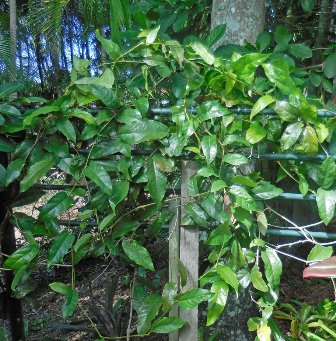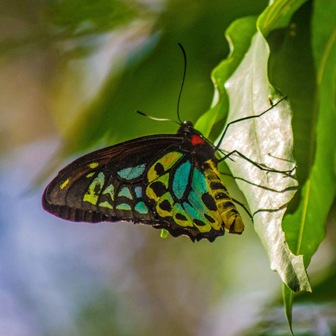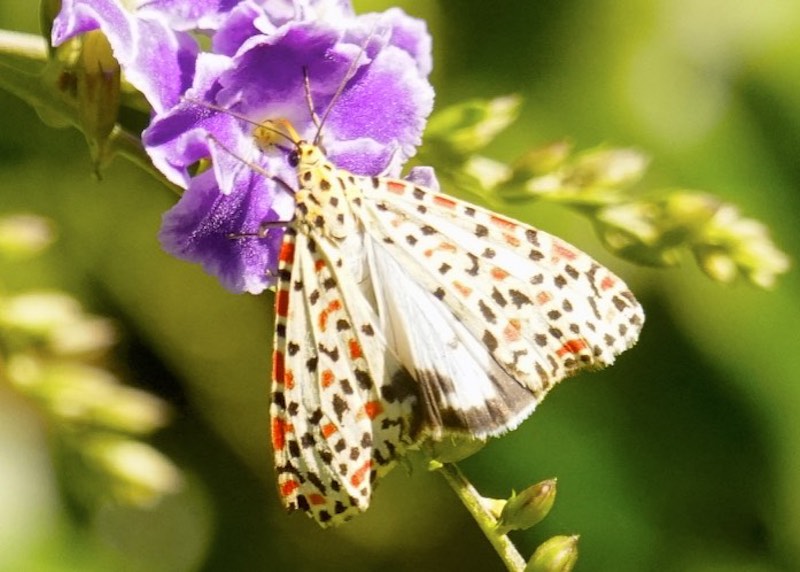The spectacular Richmond birdwing butterfly (Ornithoptera richmondia) is the largest butterfly in South East Queensland and Northern New South Wales.
The colourful male has a wingspan of 12-13cm, with a black body, brilliant green stripes and spots on both sides of its wings, green patches on its hind wings and a bright red splash on its thorax.
Declining populations
Sadly the numbers of this strikingly beautiful insect have been in decline since the late1880’s. Its numbers and its geographical range have contracted alarmingly. In Queensland it is now listed as a vulnerable species.
The reasons for its decline are both man-made and natural. The ideal habitat for these butterflies is in lowland subtropical rainforests where the birdwing butterfly vine (Pararistolochia praevenosa and P. Laheyana) is available to support the butterflies during their immature stages as larvae.

 Birdwing butterfly vine © RBCN
Birdwing butterfly vine © RBCN
Habitat loss
The destruction of habitat to make way for forestry, agriculture and urban development has decimated wide areas of habitat for these butterflies, particularly in south-east Queensland.
Pararistolochia praevenosa has been displaced by many exotic vines but one exotic in particular has had a devastating effect on local populations.
The Dutchman’s pipe vine (Aristolochia elegans) is an exotic species introduced from South America. It is similar in appearance to Pararistolochia praevenosa and attracts the female butterflies who lay their eggs on its leaves. Those leaves are highly toxic to any larvae which emerge. Sadly Dutchman’s pipe is more attractive to female butterflies than Pararistolochia praevenosa. Despite efforts to eradicate it, Dutchman’s pipe continues to thrive in gardens. It has escaped and now proliferates many bushland and waterway areas. It is very prevalent in the western suburbs of Brisbane.
Periodic instances of prolonged drought have also damaged habitat, reducing the availability of soft leaves for food and denying essential moisture from growing pupae. The net result has been the isolation of a number of viable Richmond Birdwing Butterfly populations, leading to in-breeding due to population decline. In many areas, local populations have become entirely extinct.
A united conservation effort
For the past thirty years or so, a group of conservationists led by Dr Don Sands have quietly been tracking South East Queensland Richmond birdwing butterfly populations, re-establishing Pararistolochia praevenosa vines and removing Aristolochia elegans. Their efforts have paid off with a resurgence of the butterfly in the Sunshine Coast and Gold Coast hinterland regions.
Now the focus is on Brisbane. In an outstanding demonstration of collaboration many conservation groups and local residents have united with Brisbane City Council and the Richmond Birdwing Conservation Network (RBCN) in a determined effort to save the Richmond birdwing butterfly from extinction within the Brisbane environs.
In 2017 the “Bringing the Richmond Birdwing Butterfly Back to Brisbane” project was launched.
This is one of several projects which aim to systematically map the spread of Aristolochia elegans, map the current range and future range of the Richmond birdwing butterfly as a result of climate change, as well as co-ordinating plantings of Pararistolochia praevenosa in “corridors” throughout Brisbane.
The intention is that these “corridors” will allow separate colonies to breed and thrive, encouraging the likelihood of mating between non-related insects to produce stronger, more viable populations. Several corridors have been identified as being critical to the survival of the Richmond birdwing vine and butterfly. These include sites in the Gold and Sunshine Coast hinterlands and in the western suburbs of Brisbane.
The MCCG and residents of the catchment are contributing greatly to help establish these corridors. The aim is to join up with current and future plantings in other council areas both north and south of Brisbane.
Cody Hochen is a Wildlife Conservation Partnerships Officer with Brisbane City Council. He has provided the MCCG with a wonderful description of the project, its goals and successes so far (January 2019).
To read Cody’s article, please click here: Bringing back the Richmond Birdwing Butterfly
What YOU can do to help
There are MANY things you can do to help bring back the Richmond birdwing butterfly.
You can plant Pararistolochia praevenosa vines to attract larvae and remove Aristolochia elegans in your own garden or you can volunteer to join bushcare groups who work in wider areas. Pararistolochia praevenosa requires moisture, so there is often a call out for volunteers to water vines during dry spells.
There are a number of species you can plant which will attract adult Richmond birdwings as well. For more info, please see the following guide produced by the Richmond Birdwing Conservation Network: Australian Nectar Plants for Adult RBB
Other activities you can join include:
- Restoring Richmond birdwing habitats
- Supporting scientific research
- Hands-on school projects
- Creating flagship corridors by planting vines
- Educational publications
- Removing Dutchman’s pipe vines.
The Richmond Birdwing Conservation Network has a wealth of information to help you find you a part to play. Call them on 3844 0129 or visit their website or Facebook page (highly recommended!)
Or, for starters, refer to the following fact sheets:
- Richmond Birdwing Butterfly Factsheet
- Birdwing Butterfly Vine Factsheet
- Cultivation of Birdwing Vine Factsheet
Let’s bring back the Richmond birdwing butterfly!



